Herbert Joseph Gunnery, 1882 – 1978
by Brian Stevenson
last updated August, 2023
Herbert Gunnery had a long and varied life, living in England, Malaysia and the USA, while working as an electrical engineer, botanist, photographer and microscope slide maker. Slides bearing Gunnery’s name probably date to ca. 1911, when he operated his own business (Figures 1 and 2). In addition, Gunnery managed the microscope slide department of Ward’s Natural Science Establishment in the mid-1930s. His mother was a sister of Abraham Flatters, the famous Manchester microscopist, and it is probable that Gunnery worked for his uncle at some time or another.

Figure 1.
Examples of microscope slides prepared by Herbert Gunnery, circa 1911. The mounter later worked as a professional botanist, and the vast majority of Gunnery slides contain botanical subjects. Presumably, the machine-printed label is of later vintage.
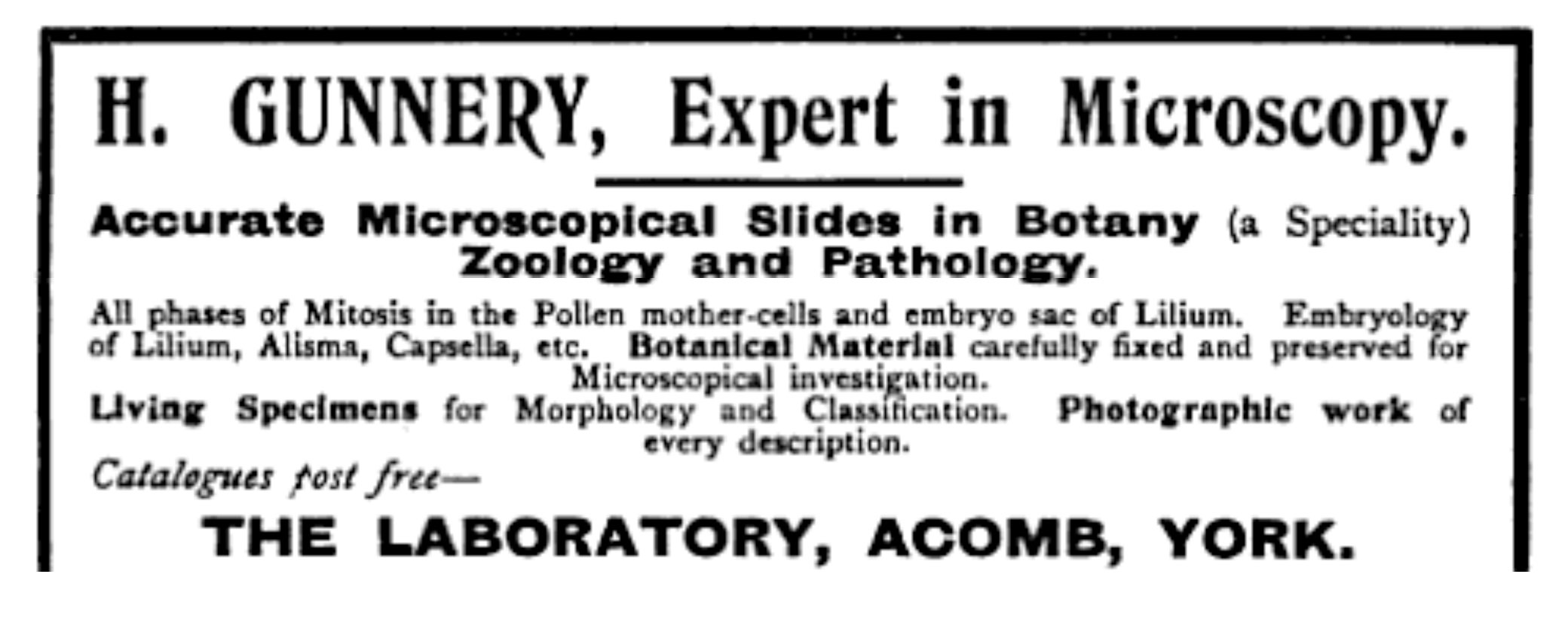
Figure 2.
Advertisement from ‘Life and Matter’ by Sir Oliver Lodge, 1911.
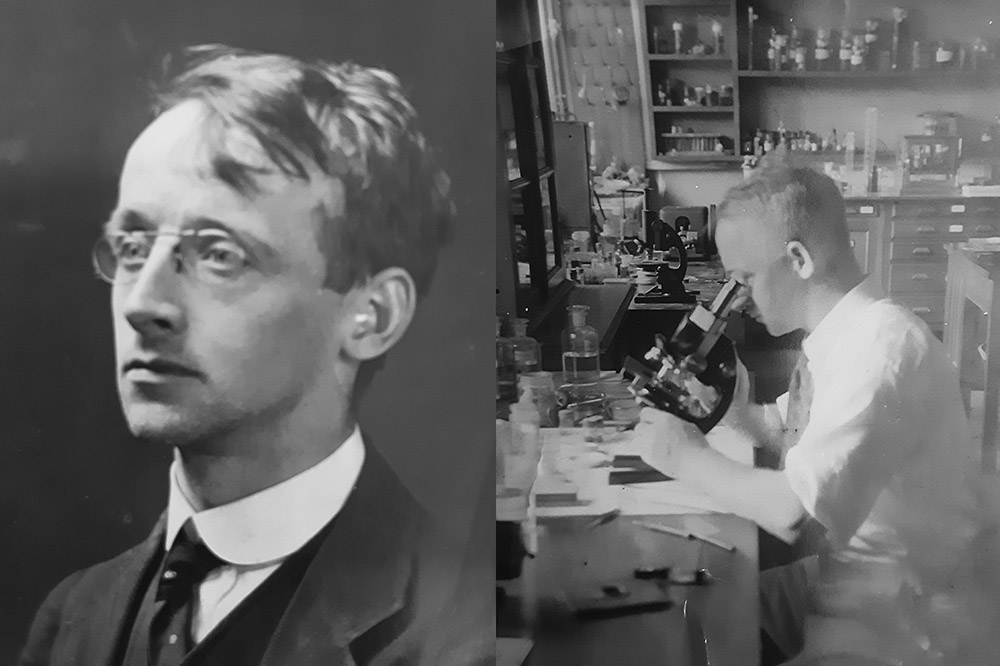
Figure 3.
Circa 1910 photographs of Herbert Gunnery. The right image shows him at work in his business, “The Laboratory”. Courtesy of H. Gunnery’s granddaughter, Jill West.
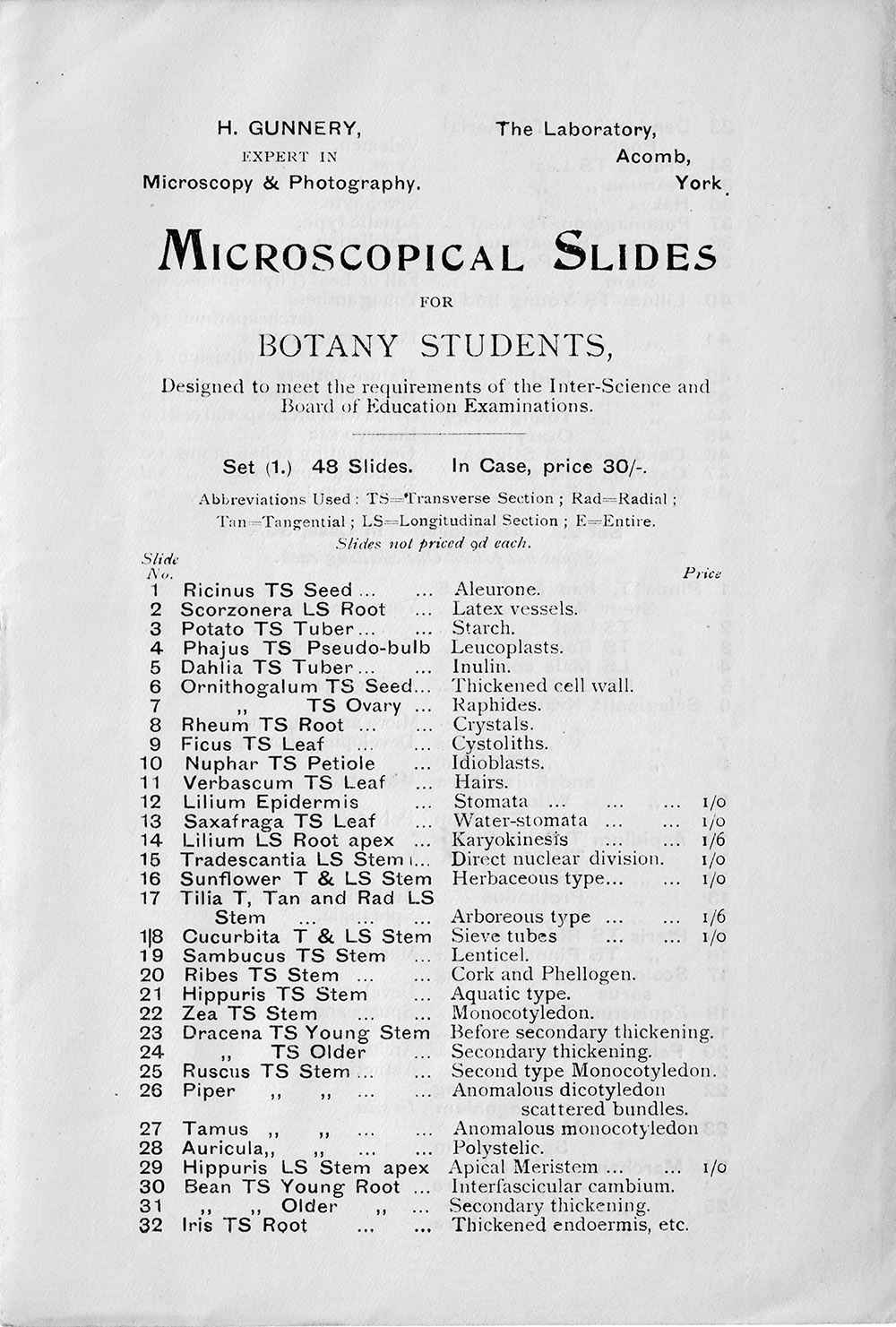
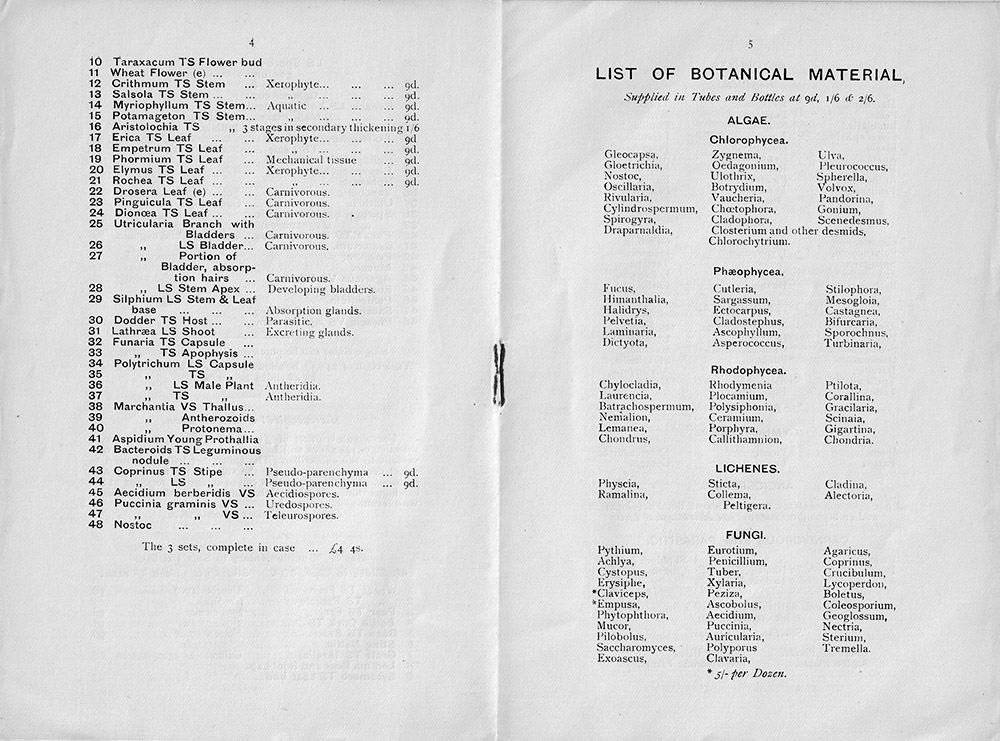
Figure 4.
Cover and inside pages of an undated catalogue of Herbert Gunnery's botanical preparations. Courtesy of Phil Whiley.
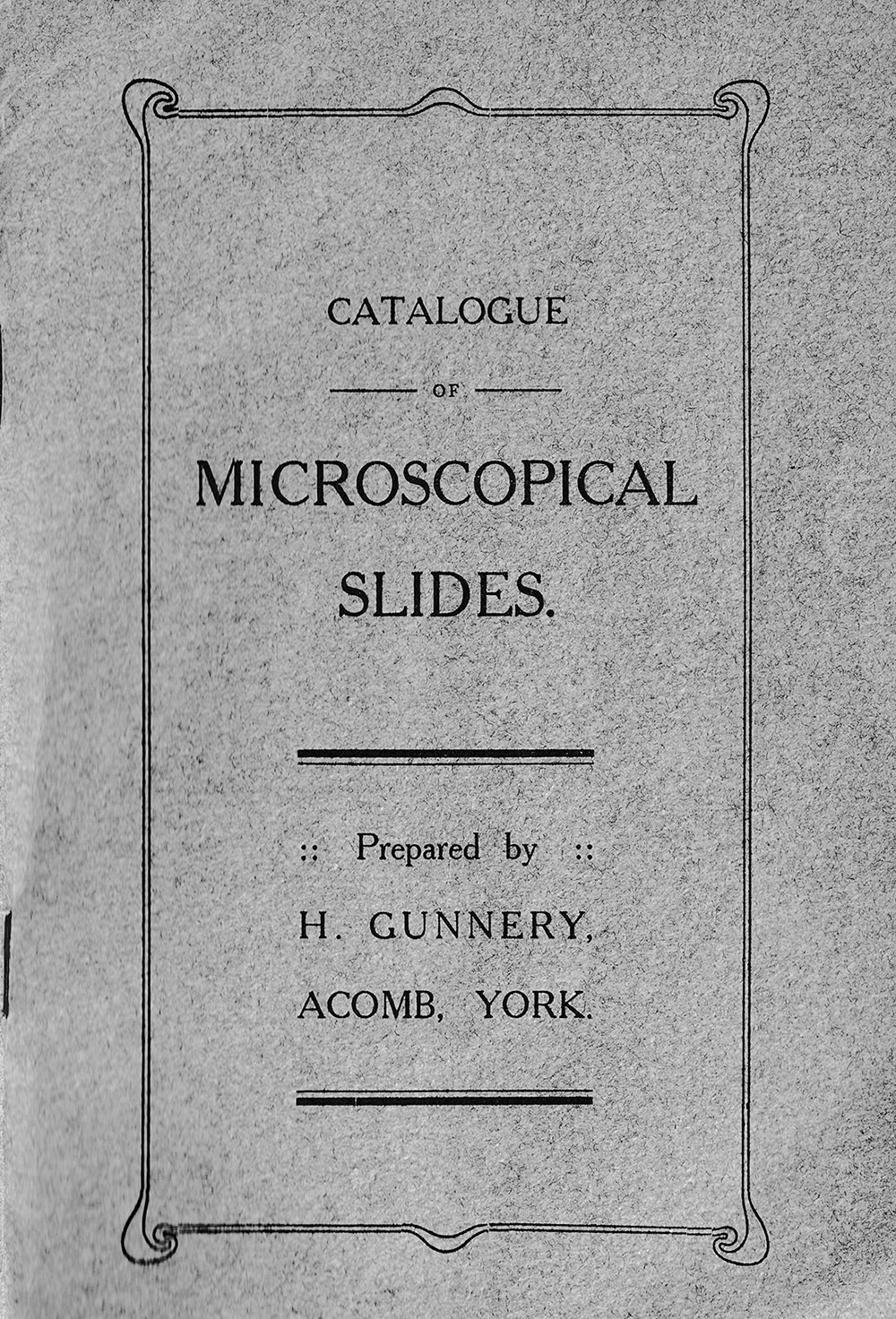
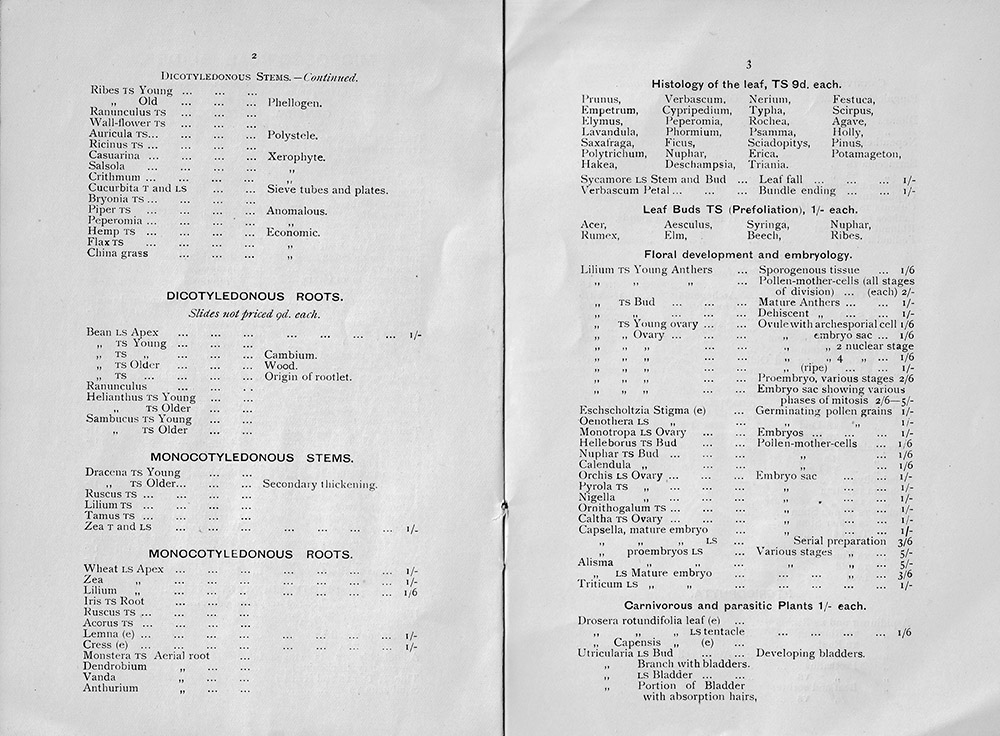
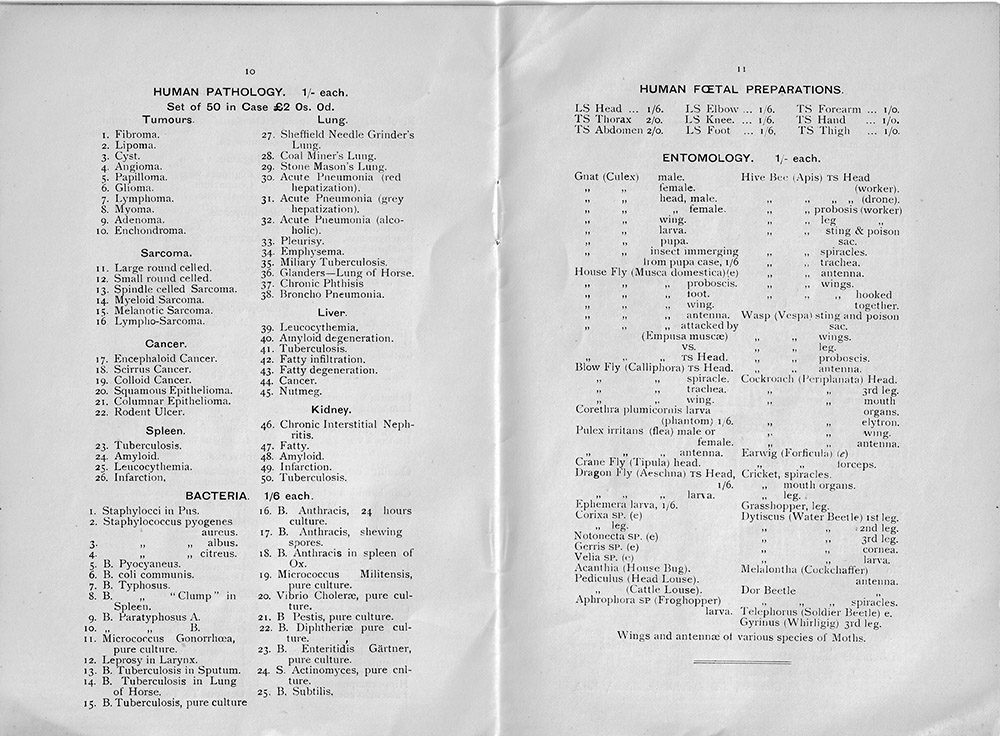
Figure 5.
Excerpts from an undated Herbert Gunnery catalogue, showing that he prepared a range of non-botanical specimens. Courtesy of Phil Whiley.
Herbert
Joseph Gunnery was born December 5, 1882, the fifth child of Joseph and Emily Gunnery. He was christened February 18, 1883, at St. Clement’s Parish Church, Salford, Lancashire (near Manchester). Father Joseph was a railway “signalman”, and mother Emily often worked as a “laundress”. Emily’s brother, Abraham Flatters, also worked on the railway during the late 1800s.
The 1901 census of England recorded 18 year-old Herbert as being an “electric engineering apprentice”.
Herbert
Gunnery joined the Manchester Microscopical Society in 1905. At that time, he
lived at 5 Nelson Street, Rusholme. This was just off Oxford Road, adjacent to
the University of Manchester. By 1906, Gunnery had moved to 13 Albert Terrace,
in the Acomb suburb of York. Gunnery’s interests in both microscopy and photography
were evident from his exhibitions to the Manchester Club, which, in 1907,
included a preparation of Penicillium
mold and a 500x photomicrograph of the “embryo-sac”
of a lily. Gunnery appears to have resigned from the Manchester Microscopical
Society in 1908, as he is not listed in membership rolls after that year.
Gunnery
was also a member of the Liverpool Marine Biology Committee. Associated with that group, he spent April 13-18, 1907, at the Marine Biological Station, Port Erin, Isle of Man.
Herbert Gunnery married Jennie Payne in the spring of 1908, in Chorlton, Lancashire. They had two children, Max and Irene.
Gunnery’s scientific business, “The Laboratory”, was in operation by 1910. In that year, the magazine Knowledge published “a photograph by Mr. H. Gunnery, The Laboratory, Acomb, York”, of a toothwort, Lathraea squamaria.
On the
1911 census, Gunnery reported himself to be a “microscopist”, self employed, and working from the family home of 13 Albert Terrace, Acomb.
The advertisement shown above in Figure 2 was published in 1911. Gunnery also promoted his products by giving free samples to magazine editors and clubs. For example, Knowledge
magazine wrote in 1911, “We have received a selection of slides from Mr. H. Gunnery, Acomb,
York. He has specially devoted himself to the preparation of slides illustrating the phases of development in the
embryo-sac and pollen mother-cells of Lilium spp. The slides we have examined
are very good indeed. Special mention may be made of one, showing the embryo-sac containing two
daughter-nuclei resulting from the first division of the nucleus of the
megaspore. Mr. Gunnery has also sent for examination sets of botanical slides,
designed to meet the requirements of the Intermediate Science and Board of
Education Examinations. All the types are well illustrated in these sets, which are very reasonable
in price
Nineteen botanical slides, and several photographic lantern slides, were provided to the Quekett Microscopical Club for exhibit on January 24, 1911: "Mr. H. Gunnery, of Acomb, York, sent for
exhibition a large number of botanical preparations, some especially good sections, showing mitotic figures and various stages of nuclear division, being much admired. The thanks of the meeting were accorded to Mr. Gunnery and also to Mr. C. Baker, who kindly provided the microscopes used. Mr. Gunnery also sent a number of lantern slides, mostly photomicrographs, some of excellent preparations of Lilium, showing various stages of nuclear division. Another good photograph was of Empusa
muscae, disease of house-fly, a L.S. of abdomen of fly, showing the fungal hyphae breaking out at the abdominal segments. Mr. Paulson said he thought some of the slides were of great interest, as for a long time no one knew what became of the secondary nucleus, but slide No. 8 showed them that the secondary nucleus did play an important part in fertilisation. Some very interesting experiments were
performed in Toulouse in connection with this subject, and it was studying the effects as regards secondary fertilisation that had led to considerable improvements in maize. He felt that they owed Mr. Gunnery their thanks for sending these slides for exhibition"
Abraham Flatters published The Micrologist magazine between 1909 and 1916. The April, 1914 issue included an article on fungi by Herbert Gunnery.
Gunnery enlisted in the Royal Army on December 10, 1915, at the age of
33. He joined the “Heavy Section, Machine Gun Corps”, i.e. the tank corps. He demobilized in 1919, at the end of World War I, with the rank of Lance Corporal.
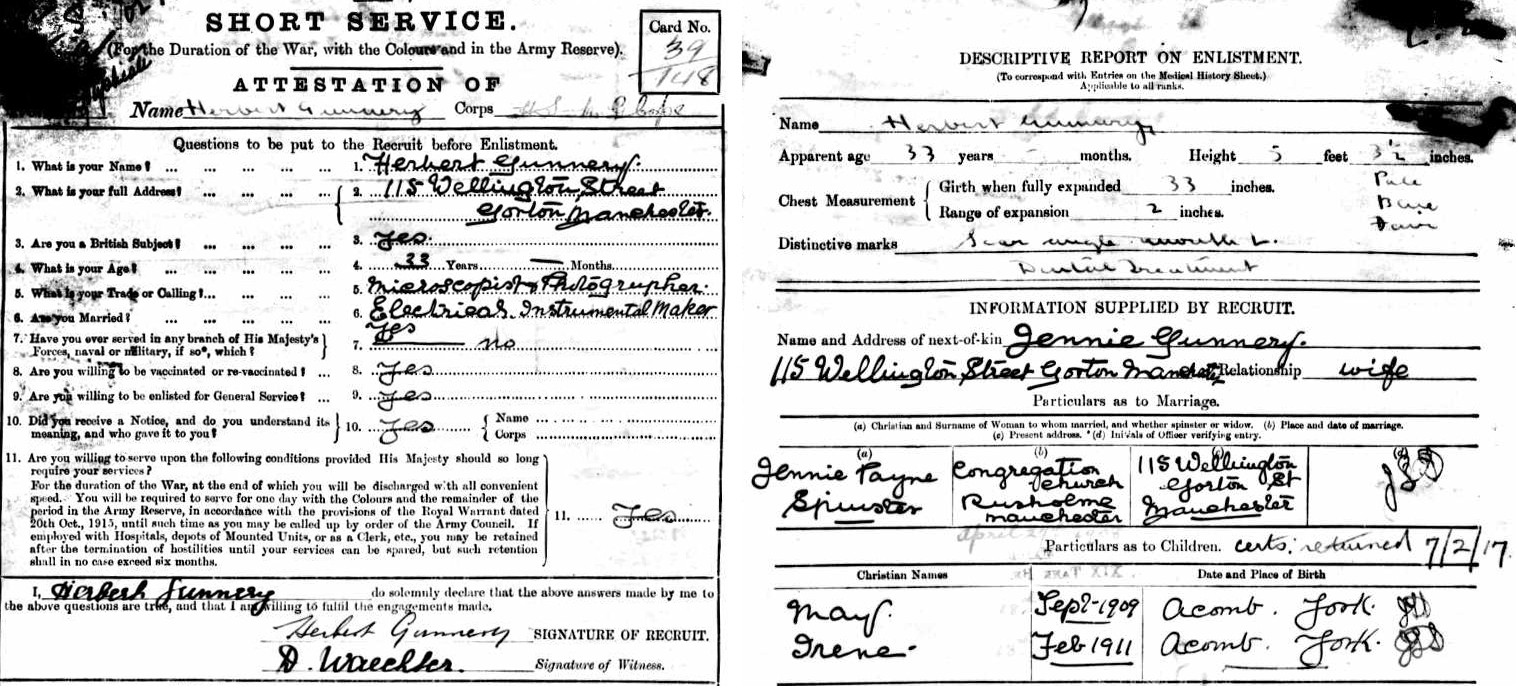
Figure 6.
Excerpts from Herbert Gunnery’s military enlistment
record, December 10, 1915. Gunnery described his occupation as ‘microscopist,
photographer (and) electrical instrument maker’. We also learn that he stood 5
feet, 3 1/2 inches tall (1.6 meters), had a pale complexion, blue eyes, fair hair and a scar at the left side of his mouth. He had received dental treatment, probably dentures. Other information indicated that he had poor eyesight and required glasses.
It is most probable that Gunnery resumed his former trades after the end
of the War. He was acknowledged for providing “microscopic and photographic preparations” to a 1925 article in The Journal of the Textile Institute, published in Manchester.
Shortly after that, Herbert Gunnery put his interest in botany to a very
different use, and began work on rubber plantations in Malaysia. Exactly when
Gunnery moved to the Far East is not clear, but he was evidently established
with his employers by 1926, as that year’s Annual
Report of the Rubber Research Institute of Malaysia stated, “Mr. H. Gunnery, Technician, was transferred to the
Pathological Division, although he still undertakes any work required for other
Divisions”.
Gunnery’s expertise in microscopy was put to good use in Malaysia. In 1929, Rubber Journal reported that “a technique for the microscopic
investigation of the caoutchouc particles in latex has been worked out by Dr.
E. Rhodes and Mr. H. Gunnery”.
Herbert remained in Malaysia while his wife, Jennie, and their 21 year-old daughter, Irene, sailed back to England in 1932. The arrived in London on June 21, with a final destination of 20 Church Road, Longsight, Manchester. That address was also associated with the microscopy company of Flatters, Milbourne & McKechnie. Jennie returned to Malaysia within the next few years.
Herbert demonstrated an interest in butterflies while in Malaysia. He collected a female Charaxes durnfordi durnfordi in Selangor during 1929, which entomologist Alexander Steven Corbet declared to be the female neotype of that butterfly. Corbet also reported that he and Gunnery collected butterflies on the Langkawi islands in the autumn of 1932. A butterfly was named Amathusia gunneryi by Corbett in 1936, although it has since been reclassified as a variety of the Palm King, Amathusia phidippus phidippus (Figure 7). Herbert also produced photographs of butterflies, contributing several to the Raffles Museum in 1932, and contributed photographs and “practical help in .. matters botanical and mycological” to Corbett’s 1935 book on tropical soils.
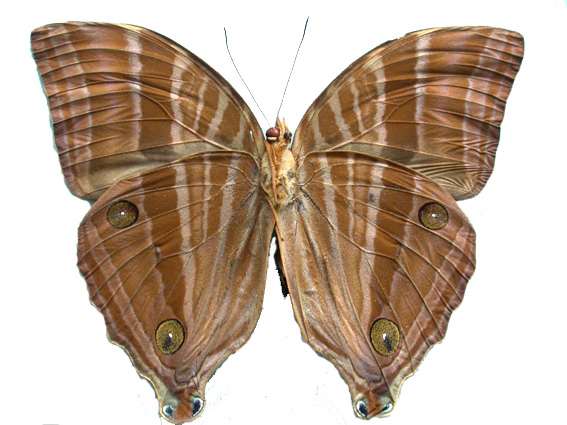
Figure 7.
Amathusia phidippus phidippus, the Palm King butterfly. This was also named ‘Amathusia gunneryi’, in honor of Herbert Gunnery. Image adapted from
http://www.nymphalidae.net/Classification/Nymphalidae_genera.htm
In 1933,
Gunnery and Arnold Sharples published a scientific paper on wound healing in
rubber trees and flowering hibiscus, in The
Annals of Botany. This included several plates showing photomicrographs of
plant sections, undoubtedly prepared and photographed by Gunnery (Figure 8).
Two years later, Gunnery published another paper, on predicting yields from Hevea plants, in The Journal of Rubber Research.
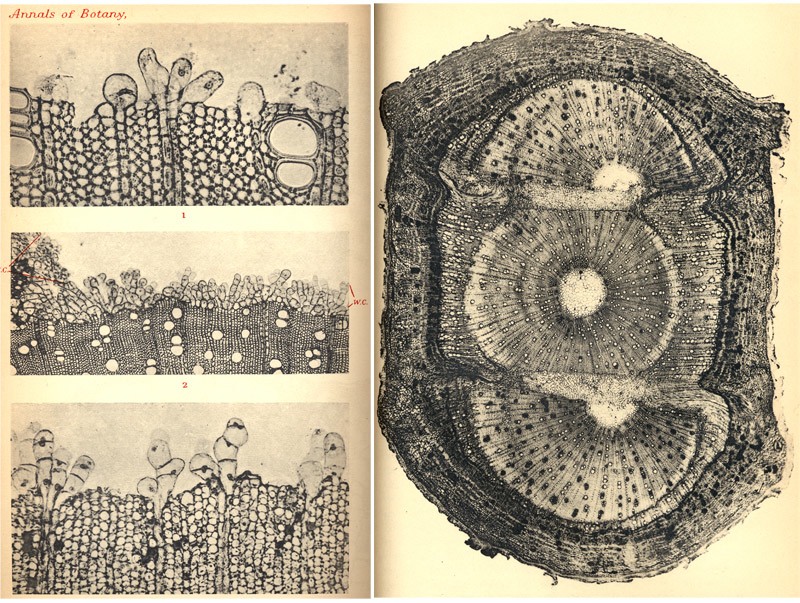
Figure 8.
Photomicrographs of plant sections, from Sharples and Gunnery, 1933.
Sharples published Diseases and Pests of the
Rubber Tree in 1936, and wrote in the preface that “the illustrations should prove of the utmost value to any planter
interested in rubber diseases. For the microphotographs, and a large number of
the ordinary photographs, I am indebted entirely to Mr. H. Gunnery. It has been
my personal feeling for many years that a great progressive step would be made
if it could be impressed upon agricultural research workers that it would be of
the greatest value if a closer touch could be maintained with the finer phases
of microscopical work. Tropical research workers are more especially in mind.
Mr. Gunnery was attached to my division for a period of twelve months, and I
can confidently state that, owing to his activities, the research work of the
division went forward very satisfactorily. All the intimate details, relating
to the fungi associated with the various diseases of rubber trees, which could
be dealt with during a short
period were disclosed and new facts were obtained in every single instance”.
Herbert and Jennie traveled together from Malaysia to England in 1935,
arriving in Southampton on August 14.
Shortly thereafter, “Herbert J. Gunnery, of Manchester, England .. joined the staff of Ward's Natural Science Establishment, in charge of the microscope slide department”. Ward’s was located in Rochester, New York, USA. Jennie sailed on the Queen Mary to join her husband in December, 1936.
That venture did not last long, as Herbert and Jennie arrived back in Southampton, England, from New York, on December 29, 1937. They again gave their home address as 20 Church Road, Longsight, Manchester.
The records of the California marine biologist Edward Ricketts (who was made famous by John Steinbeck’s Cannery Row and Sea of Cortez) indicate that he received letters from Herbert Gunnery in 1937.
A census of England was taken in 1839, at the outbreak of the Second World War. At that time, Herbert and his wife were living in Portslade-by-Sea, Sussex, where he worked as a “Technical Microscopist.
The Gunnerys moved to London by 1942. In that year, Herbert Gunnery was elected to be a Fellow of the Royal Microscopical Society. In 1948, he joined the Quekett Microscopical Club. At that time, his address was 7 Chester Court, Monks Drive, London W3.
Jennie Gunnery died in Pwllheli, Caernarvonshire, Wales during the summer of 1957. Herbert died on January 1, 1978 in Macclesfield, Cheshire, at the age of 95.
Acknowledgements
Many thanks to Pat and Mary Morris for their kind gift of Gunnery’s slides, to Jill West for sharing pictures and other information about her grandfather, to Steven Gill for generously sharing genealogical information on, to Maureen Carter for providing images, and to Phil Whiley for sharing images of Gunnery's catalogues.
Resources
Annual Report and Transactions, Manchester Microscopical Society (1905) List of members, page 87
Annual Report and Transactions, Manchester Microscopical Society (1906) List of members, page 94
Annual Report and Transactions, Manchester Microscopical Society (1907) Page 9, and List of members, page 87
Annual Report and Transactions, Manchester Microscopical Society (1908) List of members, page 87
Annual Report of the Rubber
Institute of Malaya (1926)
Armitage, F.D. (1943) Further uses for chlorazol black E and a new stain
for botanical sections, Journal of the
Royal Microscopical Society, Vol. 63, pages 14-19
Bracegirdle, Brian (1998) Microscopical
Mounts and Mounters, Quekett Microscopical Club, London, pages 48 and 142,
plate 19-L
Bulletin of the Raffles Museum (1932)
Christening record of Herbert Joseph Gunnery (1882) St. Clement,
Salford, Lancashire, England. Baptisms 1877 - 1884, Page 175, Entry 1399, LDS Film 1786422. Accessed April, 2012 through
Online Parish Clerks – County of Lancashire, http://www.lan-opc.org.uk/Search/indexp.html
Corbet, A. Steven (1935) Biological Processes in Tropical Soils: with Special Reference to Malaysia, Heffer & Sons
Corbet, A. Steven (1937) Observations on species of Nymphalidae and Riodinidae from the Malay Peninsula, Transactions of the Royal Entomological Society B Vol. 6, pages 99-104
Corbet, A. Steven and H.M. Pendlebury (1956) The Butterflies of the Malay Peninsula, second edition, Oliver and Boyd
Edward Flanders Ricketts Papers (accessed April, 2012)
http://findingaids.stanford.edu/xtf/view?docId=ead/mss/m0291.xml
England census, birth, marriage and death records, accessed through
ancestry.co.uk
Enlistment record of Herbert Gunnery (1915) accessed through
ancestry.co.uk
Flatters, Abraham (1905) Methods in Microscopical Research: Vegetable Histology, Sherratt and Hughes, Manchester
Flatters, Milbourne & McKechnie (1910) Photomicrographs
of Botanical Studies, Flatters, Milbourne & McKechnie, Manchester
Gunnery, Herbert (1935) Yield prediction in Hevea, Journal of Rubber Research, Vol. 6, pages 8-20
Journal of the Federated Malay States Museums (1936) Google snippet, “All the other Amathusia species, we suspect, are confined to dense primeval forest, being found on the plains and at altitudes up to 4000 feet. We wish to associate the name of this interesting new species with Mr. H. Gunnery”. Vol. 18
Journal of the Quekett Microscopical Club (1911) series 2, Vol. 11, pages 228, 331 and 469
Journal of the Quekett Microscopical Club (1948) series 4, Vol. 2, page 81
and List of Members
Journal of the Royal Microscopical Society (1942) Proceedings of the Society, Vol. 62, pages 64-68
Journal of the Royal Microscopical Society (1950) Proceedings of the
Society, Vol. 70, pages 420-438
Journal of the Textile Institute (1925) Google snippet: “Miss R. Robinson and Mr. H. Gunnery have given valuable and appreciated
assistance throughout the investigation; the former with the
numerous computations involved, and the latter with the microscopic and
photographic preparations”. Vol. 16
Knowledge (1910) Google snippet: “The
accompanying illustration (from a photograph by Mr. H. Gunnery, The Laboratory, Acomb, York) gives an excellent picture of the habitat of the Toothwort (Lathraea squamaria), here parasitic on the roots of a hazel...”, Vol. 33
Knowledge (1911) Micro-slides illustrating mitosis, new series, Vol. 8, page 110
Lodge, Oliver (1911) Life and
Matter: An Exposition of Part of the Philosophy of Science, with Special
References to the Influence of Professor Haeckel, second edition, Advertisement from Herbert Gunnery included
The Marine Biological Station at Port Erin, (Isle of
Man), Being the Twenty-first Annual Report of the Liverpool Marine Biology
Committee (1907) The station record, pages 6-8
Museum News (1935?) Google snippet: “Herbert J. Gunnery, of Manchester, England,
has joined the staff of Ward's Natural Science Establishment, in charge of the
microscope slide department”. page 211
The Naturalist (1914) Google snippet: “In The
Micrologist for April, published by Messrs Flatters, Milborne and McKechnie,
Manchester, are included notes on Fungi by Herbert Gunnery, and notes on Section Cutting, Mounting, etc., by Abraham Flatters”.
Nature (1910) Book review: Photomicrographs
of Botanical Studies, by Flatters, Milbourne & McKechnie, Vol. 84,
page 296
Rubber Journal (1929) Google snippet: “A technique for the microscopic
investigation of the caoutchouc, particles in latex has been worked out by Dr.
E. Rhodes and Mr. H. Gunnery”. Vol. 78
Sharples, Albert (1936) Diseases and Pests of the Rubber Tree, Macmillan, London
Sharples, A., and H. Gunnery (1933) Callus formation in Hibiscus Rosa-sinensis L. and Hevea brasiliensis Müll. Arg., Ann. Bot. Vol. 47, pages 827-839
UK and USA incoming steamship passenger lists, accessed through
ancestry.co.uk










